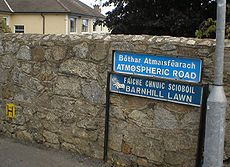
Dalkey Atmospheric Railway
Encyclopedia


Dublin and Kingstown Railway
The Dublin and Kingstown Railway , which opened in 1834, was Ireland’s first railway. It linked Westland Row in Dublin with Kingstown Harbour’s West Pier in County Dublin.-History:...
to Atmospheric Road in Dalkey
Dalkey
Dalkey is suburb of Dublin and seaside resort in Dun Laoghaire-Rathdown County, Ireland. It was founded as a Viking settlement and became an important port during the Middle Ages. According to John Clyn, it was one of the ports through which the plague entered Ireland in the mid-14th century...
, Co. Dublin, Ireland
Ireland
Ireland is an island to the northwest of continental Europe. It is the third-largest island in Europe and the twentieth-largest island on Earth...
. It used part of the Dalkey Quarry
Dalkey Quarry
Dalkey Quarry is a disused granite quarry located in the Dublin suburb of Dalkey. It was used for quarrying during the 19th century, and is now part of Killiney Hill Park, a public park...
industrial tramway, which was earlier used for the construction of Kingstown (Dún Laoghaire) Harbour. It was both the first and the longest operating railway of its type in the world.
The standard gauge
Standard gauge
The standard gauge is a widely-used track gauge . Approximately 60% of the world's existing railway lines are built to this gauge...
line was 9200 feet (2,804.2 m) in length with an average uphill gradient of about 1 in 110. Vacuum power via a 15 inches (381 mm) pipe was used for the ascent to Dalkey, speeds of up to 40 mph (64.4 km/h) being achieved, and the return journey was by means of gravity. The vacuum tube fell short of the Dalkey station, and the train relied on momentum for the last stretch of the journey.
William Dargan
William Dargan
William Dargan , an engineer, often seen as the father of Irish railways, came from Killeshin, County Laois, Ireland. Born in 1799, he constructed Ireland's first railway from Dublin to Dún Laoghaire in 1833. He constructed over of railway to important urban centres of Ireland...
was the contractor and Charles Vignoles the engineer. The atmospheric equipment was supplied by Samuel Clegg
Samuel Clegg
Samuel Clegg was a British civil engineer.Clegg was born at Manchester on 2 March 1781, received a scientific education under the care of Dr. Dalton. He was then apprenticed to Boulton and Watt, and at the Soho Manufactory witnessed many of William Murdoch's earlier experiments in the use of coal...
and Jacob and Joseph Samuda
Samuda Brothers
Samuda Brothers was an engineering and ship building firm at Cubitt Town on the Isle of Dogs in London, founded by Jacob and Joseph d'Aguilar Samuda. The site is now occupied by Samuda Estate....
.
After closure, the line was converted to the Irish standard gauge of 5 feet 3 inches (1600 mm.) A section of the path of the line now forms part of the DART
Dublin Area Rapid Transit
The Dublin Area Rapid Transit is part of the suburban railway network in Ireland, running mainly along the coastline of Dublin Bay on the Trans-Dublin route, from Greystones in County Wicklow, through Dublin to Howth and Malahide in County Dublin.Trains are powered via a 1500V DC overhead catenary...
route. The last 200 metres, or so, at the Dalkey end ran slightly to the North of the present line and is now derelict or built over. The bridge which carried Castle Park Road over the Atmospheric railway is still in existence and everyday use. The pumping station was sited in the grounds of a house which still stands beside the path called 'The Metals' adjacent to Barnhill Road

